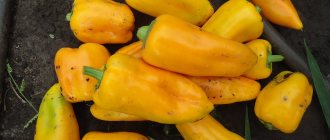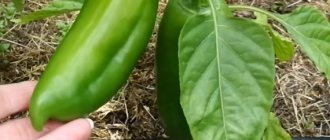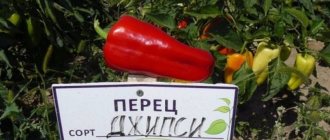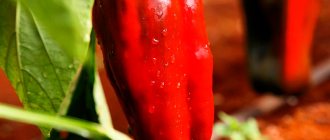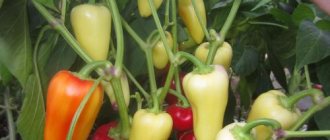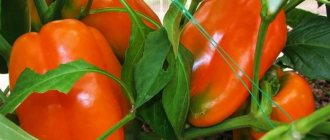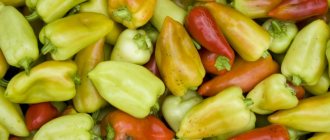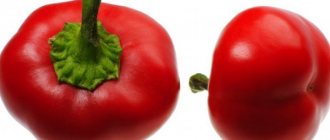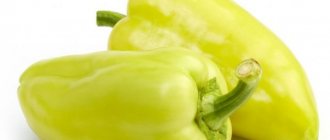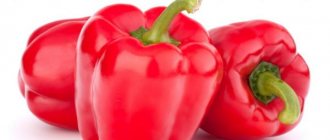Description of the variety
Although Bychok pepper is sometimes called Bulgarian, it has taken root well in different regions of Russia. Depending on the climate, it is necessary to wait 3-4 months before the first harvest is harvested.
This variety is classified as a spreading plant, reaching half a meter in height.
The leaves of the plant are green and medium in size. They have a slightly wrinkled surface. Note: the fruits of this pepper variety reach 150 g in weight and, when biologically mature, acquire one of the orange shades.
Pepper of the Bychok variety, when technically ripe, acquires a cone-shaped, rounded shape with a slightly narrowed top and weak ribbing. Inside it there are several chambers with seeds. The fruit wall reaches 5-6 mm and is distinguished by its juiciness, pleasant taste and aroma.
Pepper "Bychok": a sought-after variety with high quality fruits
Sweet bell peppers are part of everyone's diet. Even people prone to allergies can eat these vegetables, but only with yellow or orange skin. Today we will introduce you to just such a variety. He has proven himself and always shows excellent results. We will talk about the “Bychok” pepper, let’s get to know it based on the characteristics and description of the variety, reviews from summer residents, and look at the photos. In the section on growing and care, you will learn all the main secrets of getting a good harvest.
general information
The variety was bred in our country and is included in the State Register. It is quite popular as it shows good results in greenhouses and outdoors. Growing involves some nuances, but they are all easily doable. Summer residents appreciate Bychok for its taste, productivity, and versatility.
The fruits, as can be seen in the photo, are orange in color. These varieties of pepper have a richer vitamin composition than red varieties. The latter can cause allergies in some people. This does not happen with yellow-orange vegetables. The variety can be consumed during a diet, in the postoperative period, and given to young children. “Bychok” is perfectly stored and can be kept in the freezer all year round; it can also be dried and used as a seasoning.
Characteristics and description
Description of the bush
This variety grows quite compactly. The bushes do not exceed half a meter in height, they are not very spreading. That is, up to 6 seedlings can be planted on one square meter. The leaves are dark green, their number is medium. The variety has a rather superficial root system, which can be easily injured during loosening and weeding; you need to be extremely careful. The bushes grow well and bear fruit in light soils with a neutral pH. The variety does not tolerate swampy, heavy soil and clay.
Fruit
A description of the “Bychok” pepper variety cannot be complete without talking about its fruits. They have the shape of a wide pyramid. The pepper cannot be called thick-walled, since its width is about 5 mm, but it can withstand stuffing well. The fruits are stored well in the freezer and can be used for canning or squeezing juice for therapy.
Maturation
This variety can be classified as mid-season. From the moment the seedlings emerge until the first harvest, depending on the region and growing conditions, 110-120 days pass.
The fruits ripen quite smoothly; in the technical ripeness phase they are green, when ripe they are deep orange. To get the harvest early and in large quantities, the variety needs to be well fed. This is one of the important conditions in agricultural technology.
Resistance to diseases and pests
Having talked about the characteristics and descriptions of the sweet pepper variety “Bychok”, we did not talk about a very important fact - ailments. Diseases can quickly destroy any crop, as can pests. But “Bychok” is a rather strong variety in this regard. Pre-sowing seed treatment, competent agricultural technology and compliance with predecessors are the factors that help avoid the risks of disease.
Advantages and disadvantages
Pepper Bychok has become widespread due to a number of undoubted advantages:
- This species belongs to the universal varieties that take root in different climatic zones.
- The variety showed good results in greenhouse conditions and when planted in open ground.
- One of the undoubted advantages of this variety of pepper is its high yield. So, from a plot the size of a square meter you can get about 5 kg of harvest or more.
- During the selection process, the variety was vaccinated against fungal infections and other diseases dangerous to the plant. This makes the work of the summer resident easier.
- The fruits of this type of pepper are distinguished not only by a large amount of vitamins, but also by a pleasant taste. A large number of culinary recipes have been invented using them. This ensures constant high demand for this type of pepper.
When growing this crop, it is worth considering that a lack of light and heat can affect the health of the seedlings and at the same time reduce the yield. Among the main disadvantages, gardeners point out only the high price of seeds.
Reviews from those who planted
“They always plant this variety of pepper because it is not only tasty, but also rich in carotene. I also like its large orange fruits. They look so beautiful in the garden beds. Harvesting is a pleasure. There is so much of it that I don’t even have any free drawers left.”
“My Bychok pepper grows in a greenhouse. From one bush I harvest almost 7 kg of crop. We have to sell the excess to neighbors and friends. They are already accustomed to turning to me for vegetables and are always waiting for a new harvest. There are no complaints about the quality of the fruit. They are not only large and juicy, but also quite elastic, so they do not crack from their weight.”
This pepper variety can be grown not only to meet the needs of your family, but also for sale. The fruit is conveniently transported and can be stored for a long time. Pepper contains many vitamins that are beneficial to our body, as well as carotene. After all, its deficiency affects health.
Time to prepare seedlings
In order to have time to harvest in the summer, you need to start preparing seedlings at the end of February or beginning of March. To do this, you will need to prepare fertile soil.
Tip: to get good soil and save a little money, you need to take soil from the garden and mix it with store-bought soil and sand in a 1:1:1 ratio.
As soon as the container is filled with soil, seeds are placed into it to a depth of 1-1.5 cm. The distance between future seedlings should be such that their root systems do not interfere with each other.
A prerequisite for obtaining better seed germination is the presence of heat and light. Since natural indicators are insufficient at the beginning of spring, it is necessary to provide the seedlings with all this additionally. So, a container with seedlings can be covered with film, thus creating a greenhouse effect. The second step is to provide artificial lighting, which will extend their natural daylight hours.
After the seeds germinate, you need to wait until the first two true leaves appear on the plants. For an experienced gardener, this is a sign by which the timing of picking plants is determined. After planting in separate containers, watering is necessary. After 2 weeks, you will need to fertilize the ground under the seedlings with one of the liquid compounds that can be purchased in the store.
Landing in the ground
Towards the end of spring there comes a period in which peppers are planted in open ground. From the moment the seeds are planted to the start of this process, 40-60 days pass. In order for the seedlings to take root well in the new soil, there is no need to start this process ahead of schedule. Keeping young peppers indoors for more than 60 days can cause them to become too large. This will make transportation and disembarkation difficult.
Depending on the climatic conditions in a particular area, it is worth deciding whether a greenhouse is necessary. Here it is worth considering the principle: if at night the air temperature drops below +14 degrees, the plants will need shelter.
To ensure good growth, it is necessary to determine the location for the bed and prepare it correctly. The choice will be greatly influenced by the crop that was planted in this area last season. Pepper seedlings will take root well where they previously grew:
- onion;
- cucumbers;
- pumpkin;
- cabbage;
- zucchini:
- carrot.
Please note : you should not plant Bychok peppers in beds that last season were allocated for potatoes, tomatoes, eggplants or nightshades.
It is worth remembering that heavy clay soil is not very suitable for this type of plant. You can improve the conditions on such soil by fertilizing it with peat or humus. Before planting peppers, you need to prepare the holes. They should be 30 cm apart and 50 cm between rows. This will ensure the possibility of full development of the root system for each seedling.
Immediately before placing the plant in the hole, you need to put a spoonful of mineral fertilizer on its bottom, which should then be mixed with the soil. It is important to remove the seedling from the container so as not to damage its root system. Afterwards it is carefully transferred to the hole.
First, you need to cover only half of the hole with earth, and after watering, you need to completely fill the hole. Finally, you need to install pegs and, if necessary, immediately tie up the seedlings.
Resistance to diseases and pests
Having talked about the characteristics and descriptions of the sweet pepper variety “Bychok”, we did not talk about a very important fact - ailments. Diseases can quickly destroy any crop, as can pests. But “Bychok” is a rather strong variety in this regard. Pre-sowing seed treatment, competent agricultural technology and compliance with predecessors are the factors that help avoid the risks of disease.
As for insects, they can harm most mid-season crops. Timely struggle and attention will help solve the problem quickly. You must monitor the condition of the bushes outside and in the greenhouse. Parasites may not be visible visually, as they often settle on the back side of the leaf, in the axils. The summer resident notices that the crop gets sick only when external signs appear - wilting, curling of leaves. In this case, it is necessary to wage a drastic fight with insecticides.
To prevent an attack, carry out preventative measures by planting nearby crops that insects do not like or flowers. This could be onions, garlic, or strong-smelling herbs. Tobacco dust or ash is also scattered around the area and bait is placed in the form of a sweet solution. Folk infusions based on the same herbs, garlic arrows, and spices help drive away colonies of parasites. A solution of potassium permanganate is an excellent disease prevention.
Read also: Tomato Asterix F1: variety description
Features of care
Caring for pepper shoots includes 4 required elements:
- watering;
- weeding;
- loosening;
- fertilizing
Water is one of the main conditions for growth. For watering, you should use only warm liquid at a temperature of about 24 degrees. Some gardeners use plastic bottles for this purpose. They are filled with water and left in the sun. During the day, under the influence of sunlight, their contents are heated to the required temperature.
The required amount of water in the periods before and after flowering begins is different. After planting in open ground, watering is required once a week or 2, subject to dry weather. After the start of flowering and fruit formation, the amount of liquid increases to 2-3 times a week.
An important condition for good growth and fruiting is free access of air to the roots of plants. Therefore, loosening must be done after watering or precipitation.
Tip: loosening peppers should be done with extreme caution so as not to damage the root system, which is located very close to the surface of the earth.
Plants are fertilized with fertilizers approximately 4-5 times per season. To do this, use bird droppings, which are diluted with water in a ratio of 1:15, or slurry in a ratio of 1:10. Although the Bychok variety is considered grafted, if necessary, you need to be prepared to treat it against diseases or pests.
When harvesting, there are two types of fruit ripening:
- technical ripeness is determined by the fruit reaching a certain shape without acquiring the corresponding color;
- biological ripeness presupposes full compliance of the fruit with the parameters of size, color and shape.
In some cases, you should not wait for the fruit on the branch to fully ripen. Having reached technical maturity, it will be able to acquire the desired color during storage.
Reviews about the variety
Gardeners' opinions about the Bychok variety are varied. Some prefer fruits that are fully ripe on the bush, while others recommend picking them green to achieve ripeness during storage. There is no disagreement about the quantity and quality of the collected fruits.
Obtaining strong seedlings can be difficult for new gardeners. However, after the correct selection of temperature and light conditions, this problem gradually disappears.
Marina Sergeevna, 47 years old, Azov:
I have been growing peppers for a very long time. This variety is very prolific and produces a good harvest every year. The main thing is to provide proper care.
Igor, 38 years old, p. Sunzha, Stavropol Territory:
I planted the “Bychok” pepper variety for the first time. He reaped a good harvest. The variety is very tasty. Next year I plan to plant this variety again.
